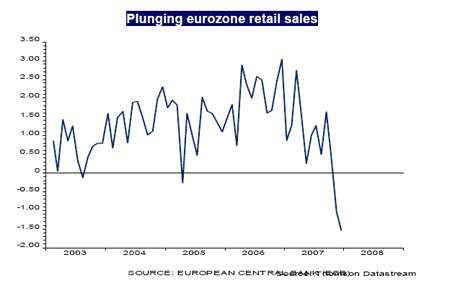
Regional economic activity is showing signs of slowing markedly but a divergent performance amongst the eurozone’s major economies suggests that activity levels have not yet reached the critical levels which would force the European Central Bank (ECB) into cutting base rates from the prevailing 4.0%.
Significantly, regional inflation remains above the Bank’s target and seems likely to remain so over the near term. Given the anti-inflation stance occupied by the ECB it seems certain to us that evidence of even greater pressure on activity levels is required before regional rates embark upon a downward path.
Global asset allocators are cutting their weightings to the eurozone and with good reason. Activity indicators are on the slide and confidence surveys are deteriorating markedly, particularly those pertaining to the assessment of future conditions. Regional Purchasing manager surveys are showing marked weakness and, as the chart below shows, retail sales are under severe pressure. Year on year retail sales across the fifteen country region were down by 1.9% in December according to recently released data, following a 1.2% annualised decline in November. If Christmas happened it was clearly a pretty downbeat affair as regional populations became increasingly concerned about the economic outlook and prospects for employment and incomes.
Even the French, with their historic penchant for setting fire to lorries on the outskirts of Paris at the slightest hint of trouble, kept their matches to themselves this time. Of greatest concern is the fact that the consumers with the greatest aversion to unpadlocking their purses and wallets are the previously freespending Spanish (for many years Western Europe’s fastest growing economy) and the Germans (still Western Europe’s largest economy).
Plunging eurozone retail sales
However, the unequivocal case for a regional base rate reduction has yet to be made. Recent Purchasing Manager Surveys indicate that activity continues to expand, albeit at a slowing pace and that sentiment remains, if not intact, then at least above critical levels.
The region’s single biggest problem is that different countries economies grow and contract at differing rates relative to each other. Right now the Italian economy is under pressure and the Spanish economy is deteriorating markedly. By contrast, the French economy is just about edging forward and Germany’s appears solid enough for now, with the prospect of Russian infrastructure rebuild promising to provide the former’s industrial and manufacturing operations with valuable additional support. It is against this backdrop that the ECB has to couch its short-term interest rate policy decisions.
A different tone from the ECB
That the central bank opted to keep base rates on hold at 4.0% will have surprised nobody, however, at the scheduled press conference M Trichet included a number of statements intended to mollify those who might have begun to think that the Bank was ignorant to the travails of the real economy. Critically, the ECB has admitted for the first time in the current cycle that “the incoming data confirms (our italics) that the risks surrounding the outlook for economic activity lie on the downside”.
Further evidence for a softening position emerged with the news that the decision to keep regional base rates was unanimous. This marks a distinct softening in attitudes amongst voting members given that the January meeting had been peppered with debate regarding upside arguments.
Such nuances form the cornerstone of eurozone macro economic policy analysis. Kremlinologists of the past know enough about the importance attached to the order in which comments are made to confirm their relative significance. For this reason it should be appreciated that M Trichet prefaced his comments regarding growth with the critical observation that, in the near-term, the risks to price stability lie to the upside. Inflation is running at an annualised rate of 3.2%, above the ECB’s comfort zone and money and credit growth remain worryingly robust. Although the central bank is clearly well aware of the regional slowdown, it is equally well aware of its primary remit, to bear down on inflationary pressure.
In this respect it’s decision to keep rates on hold differs markedly with the Bank of England which cut rates on Thursday 7th despite its near-term concerns regarding inflation. This reflects the view that the eurozone economy is less likely to experience a hard landing than might yet prove the case here in the UK.
We have increasingly argued that investors should reduce their exposure to Continental Europe. This view is supported by the fact that financial futures markets are currently pricing in 0.75% points of base rate easing by the ECB over the remainder of 2008. We suspect that this position will prove untenable and that investors will be disappointed when regional rates do not fall as far as the markets currently predict. Whilst the euro should prove well underpinned on the foreign exchanges, we suspect that regional equity markets will vote with their feet. This is not the time to be building exposure to Western European equities.
By Jeremy Batstone-Carr, Director of Private Client Research at Charles Stanley